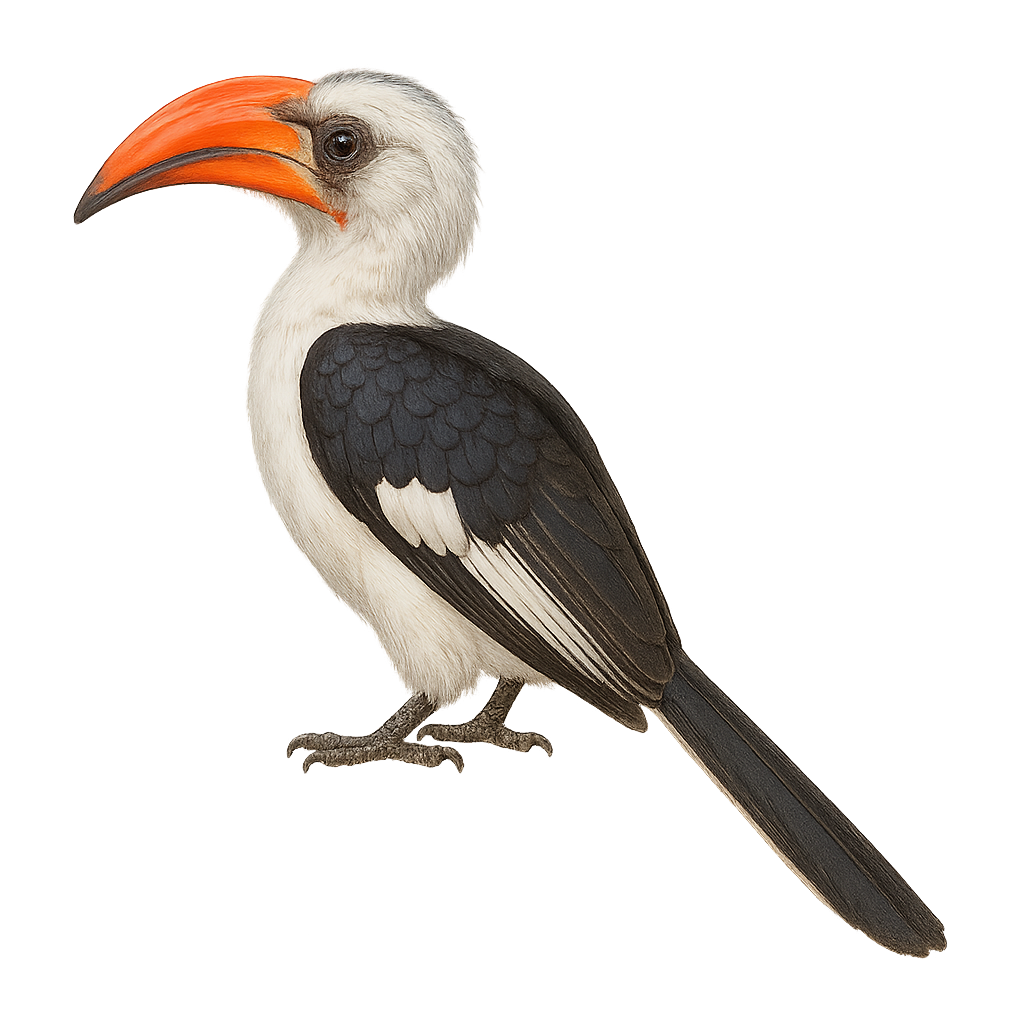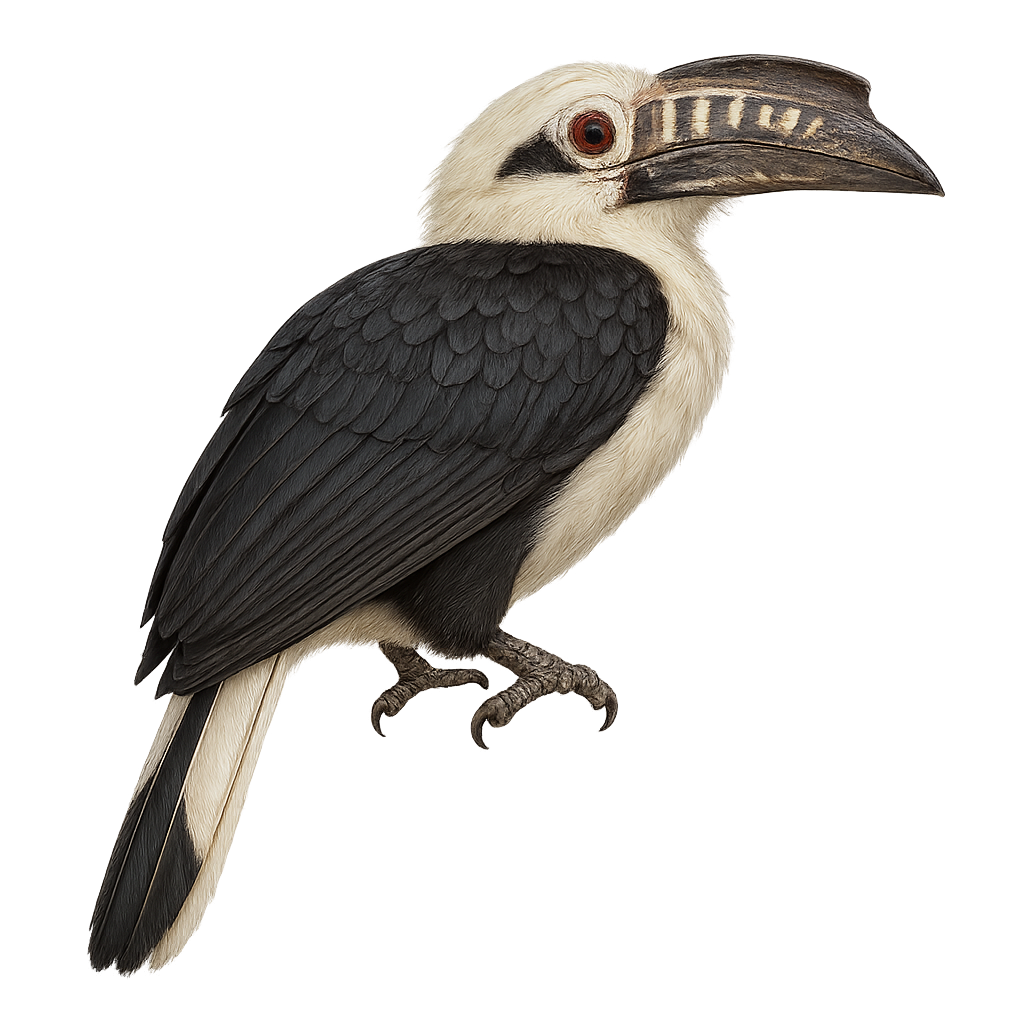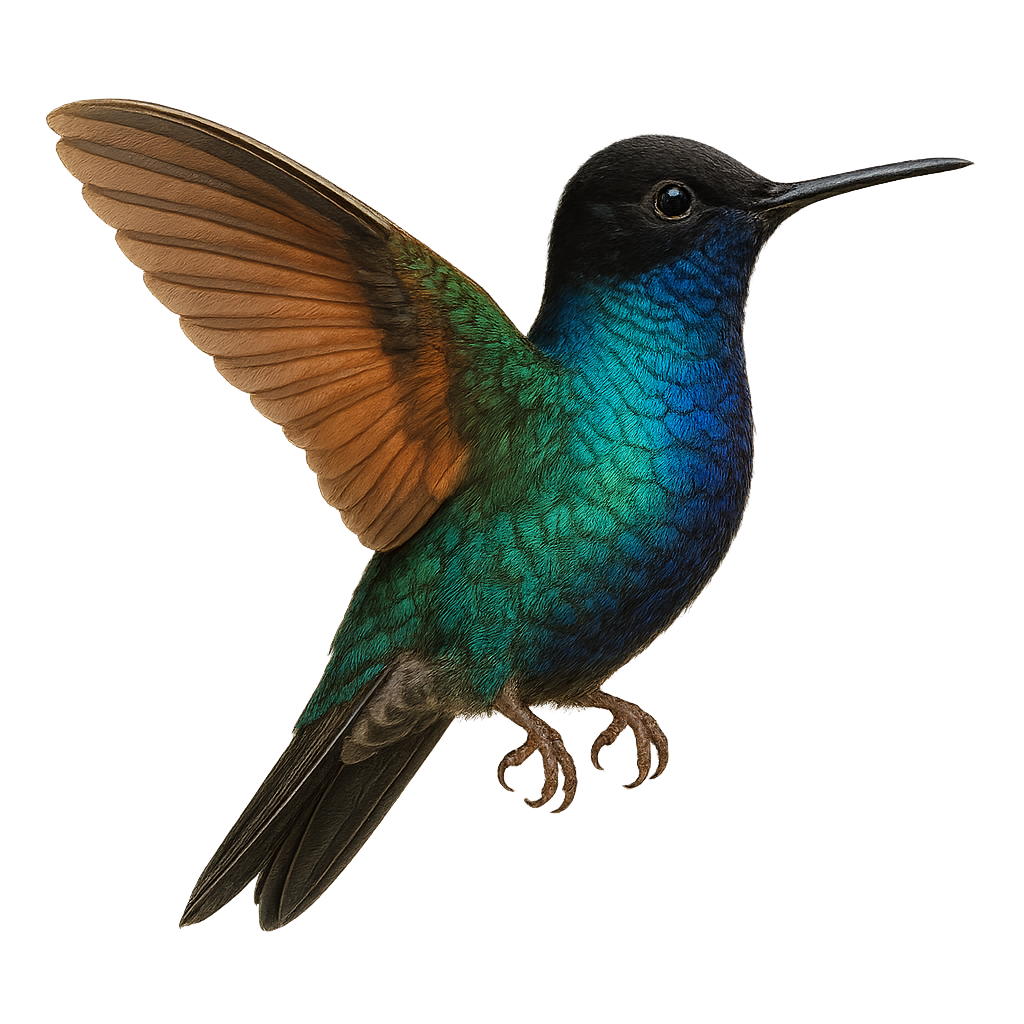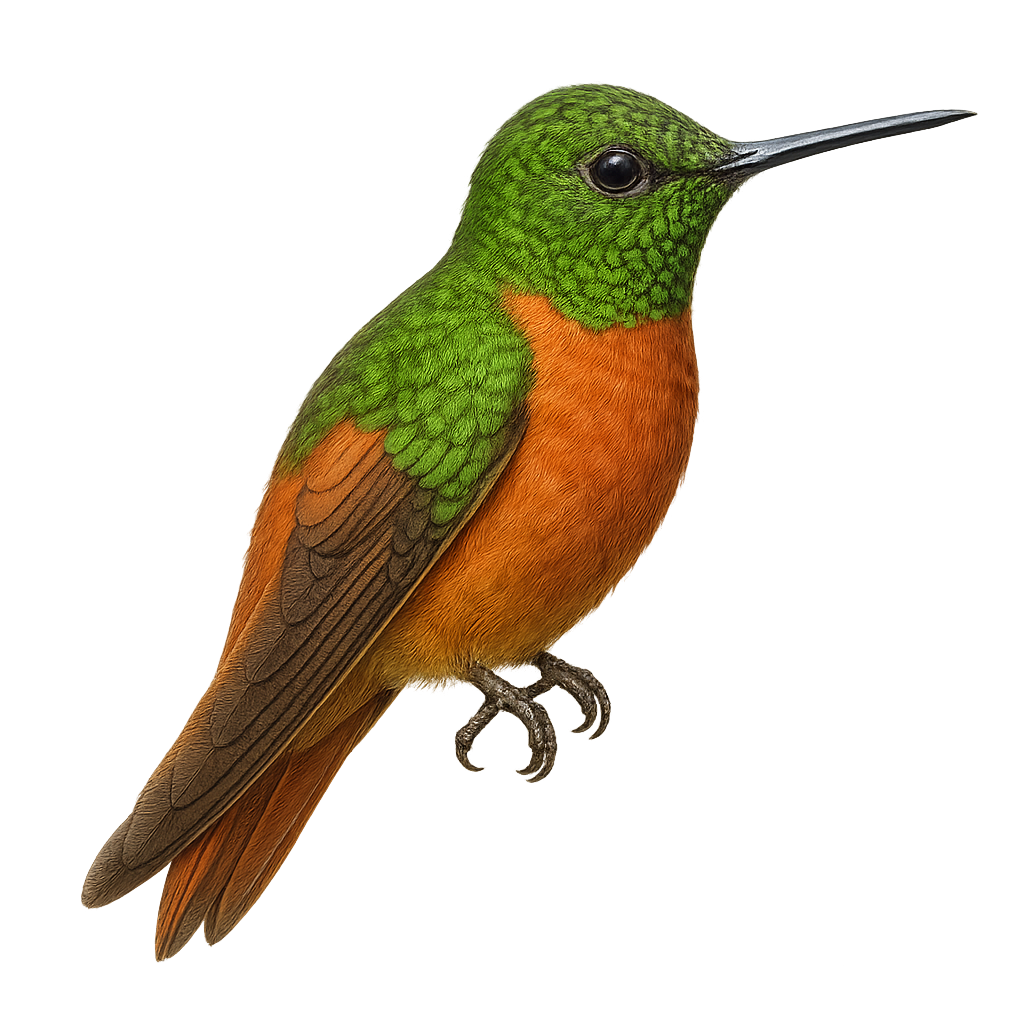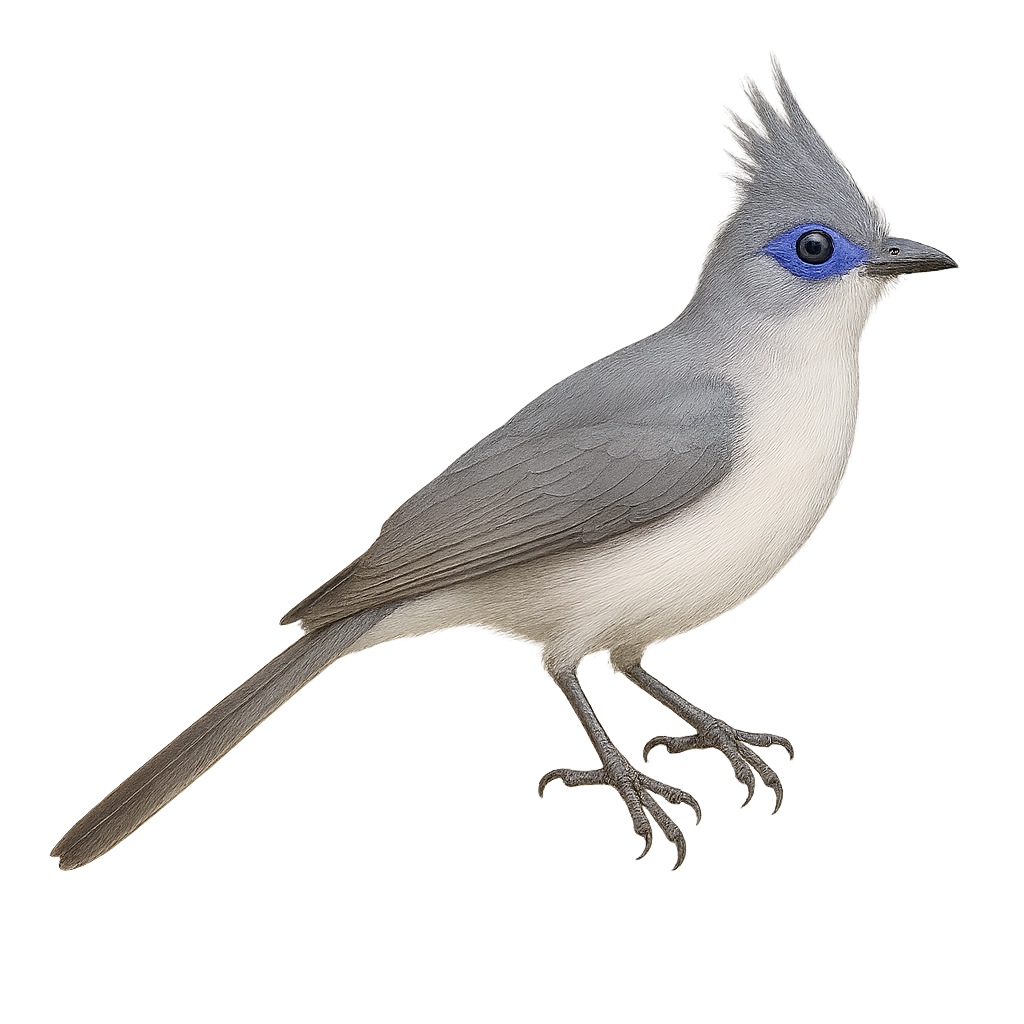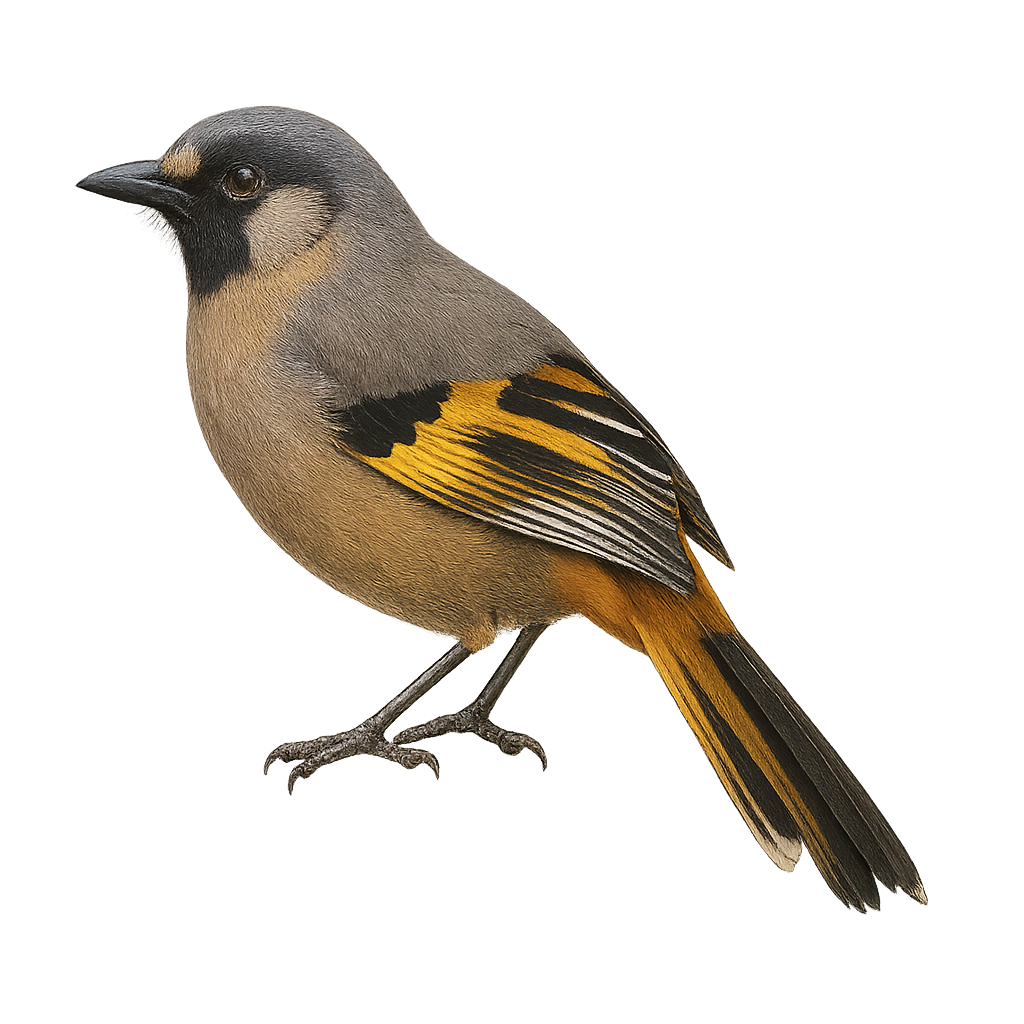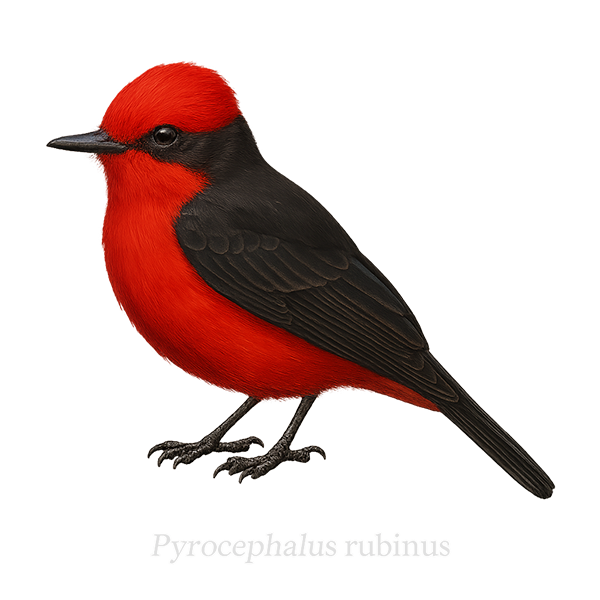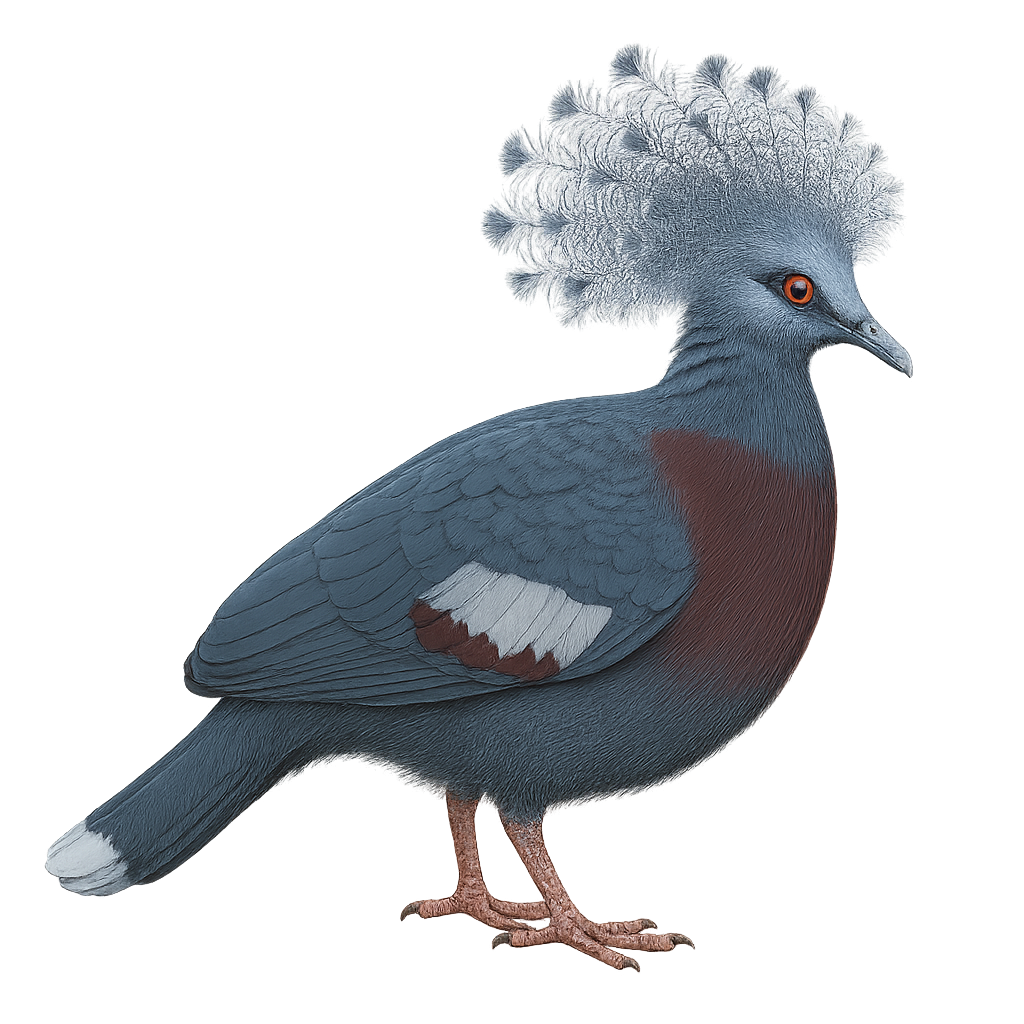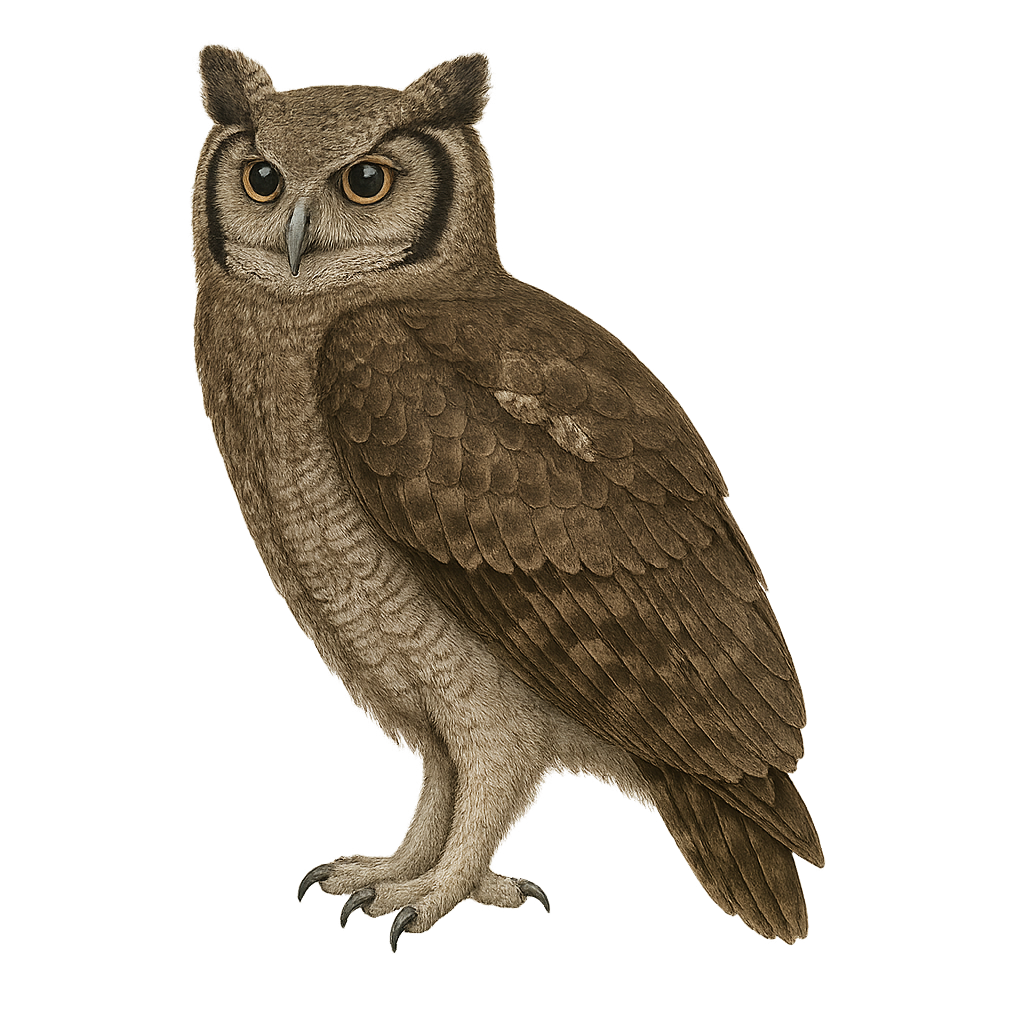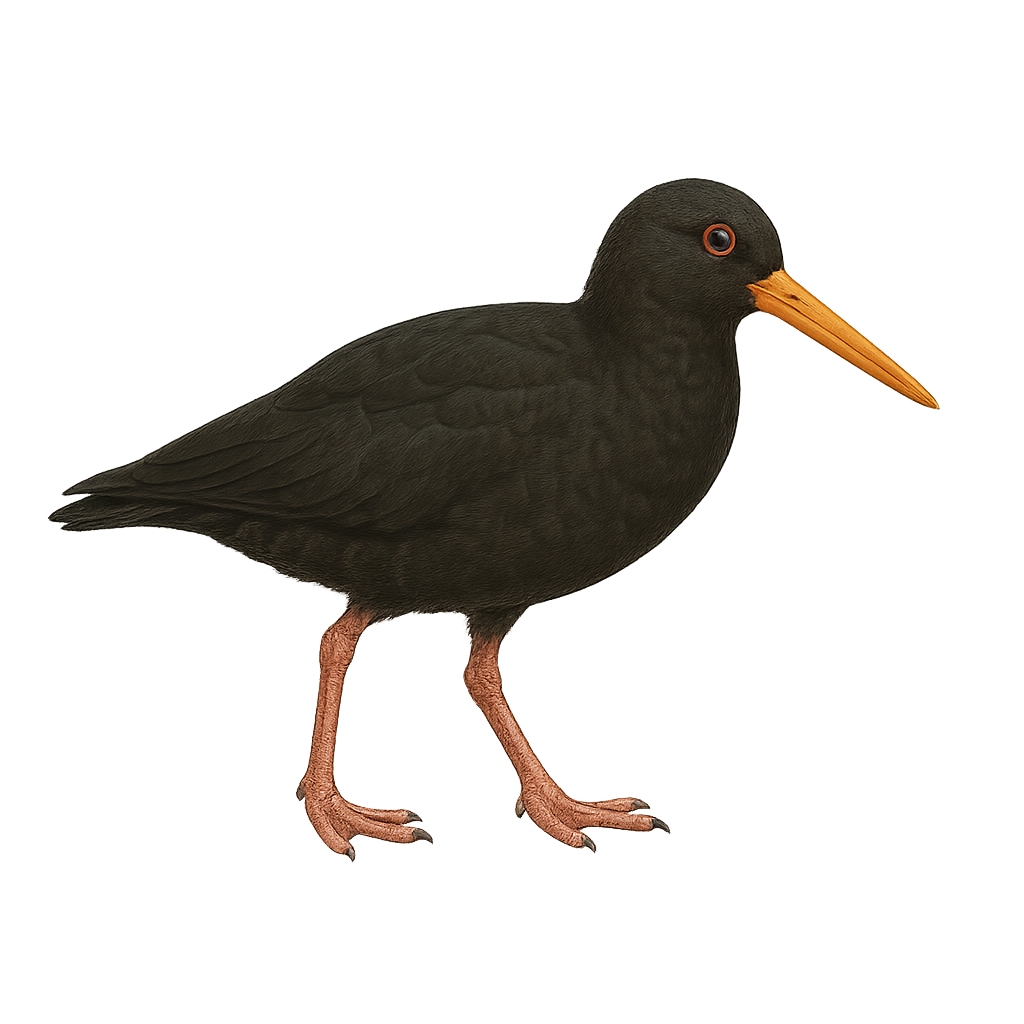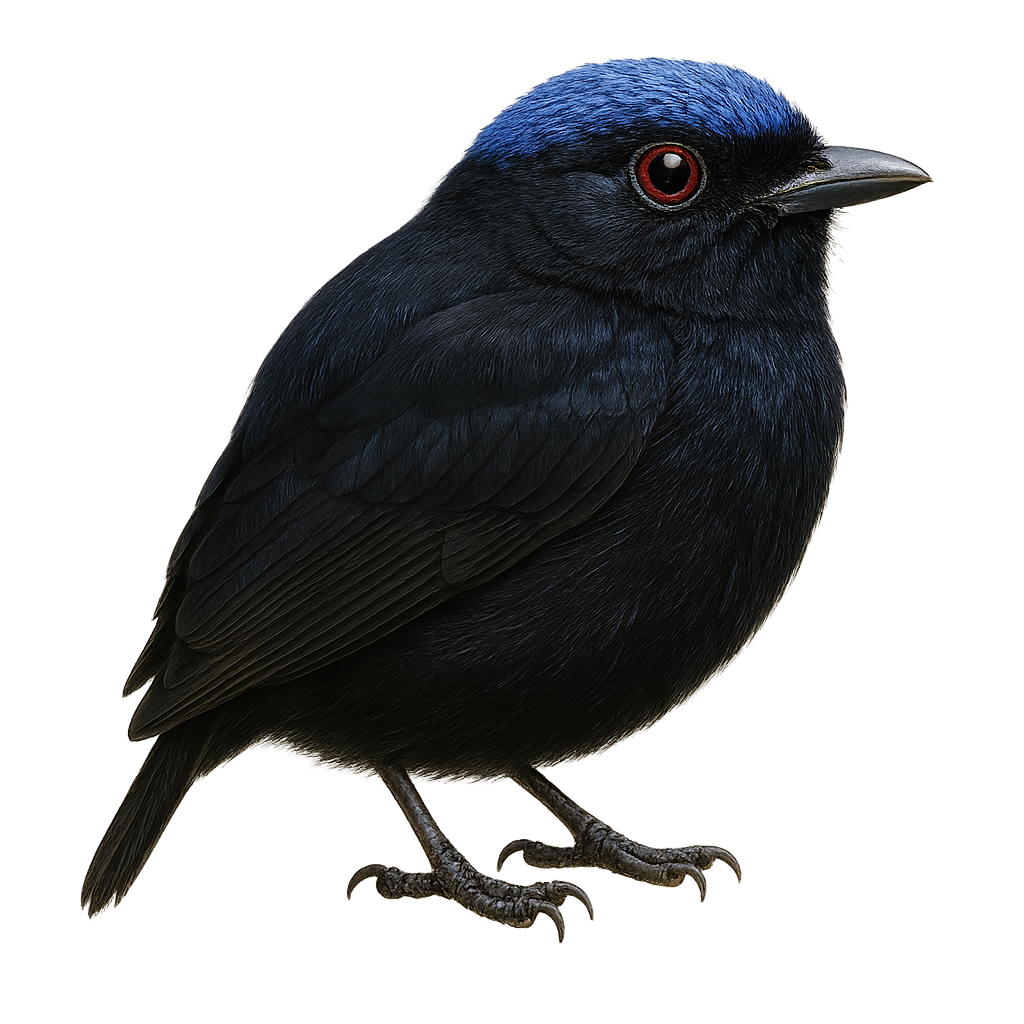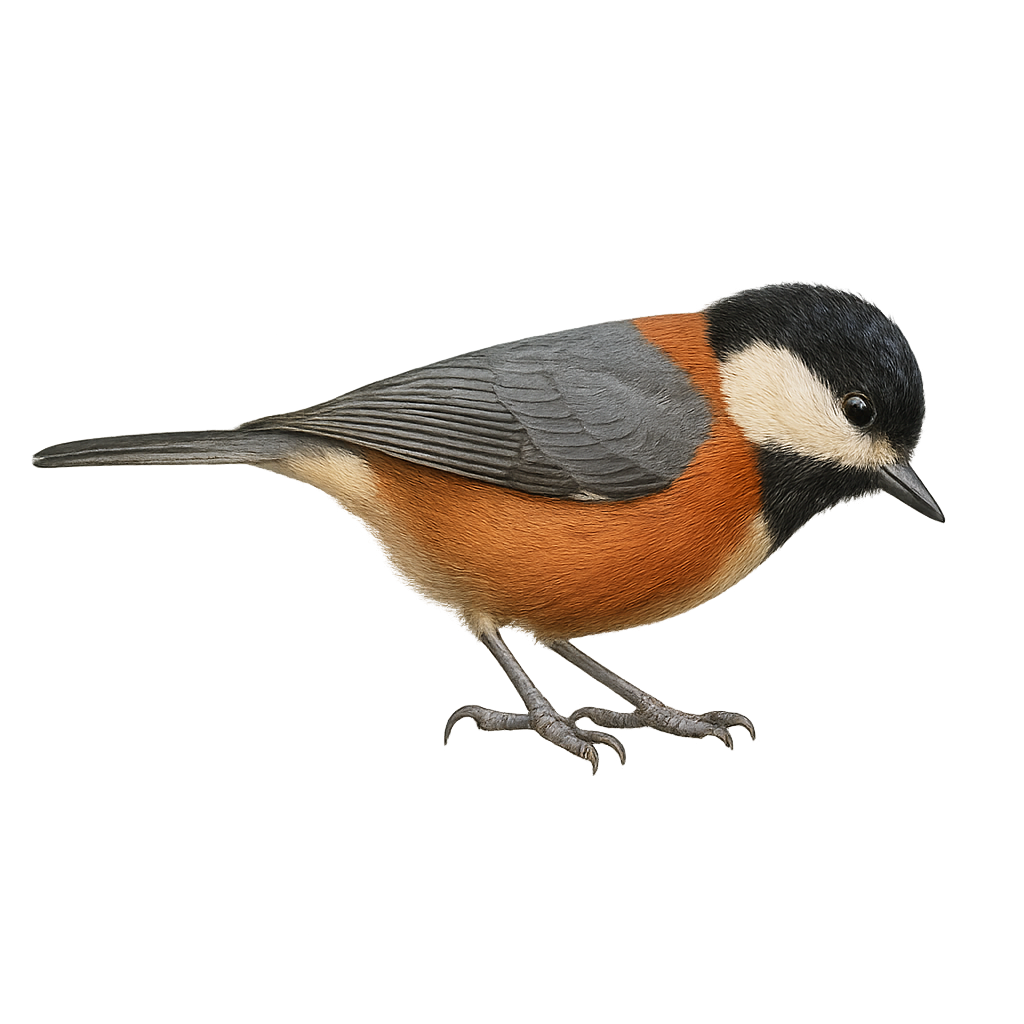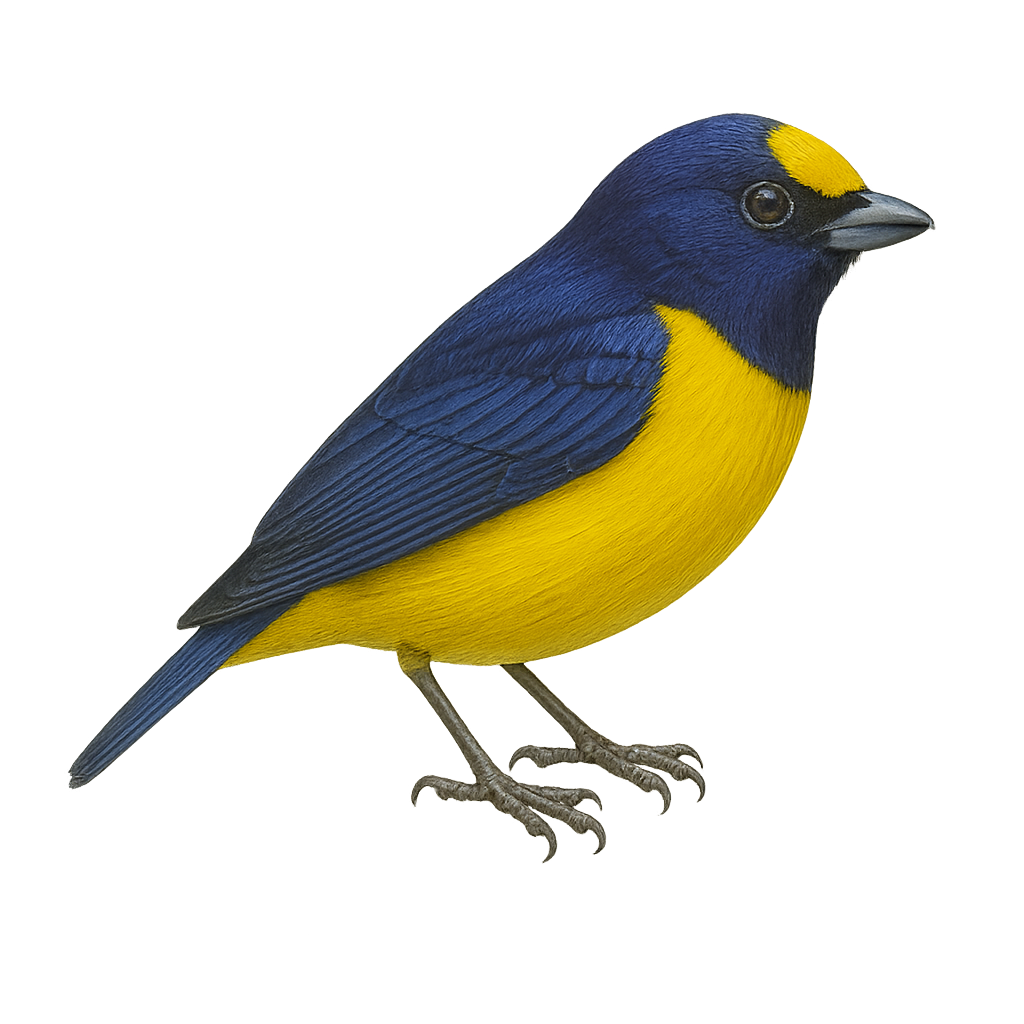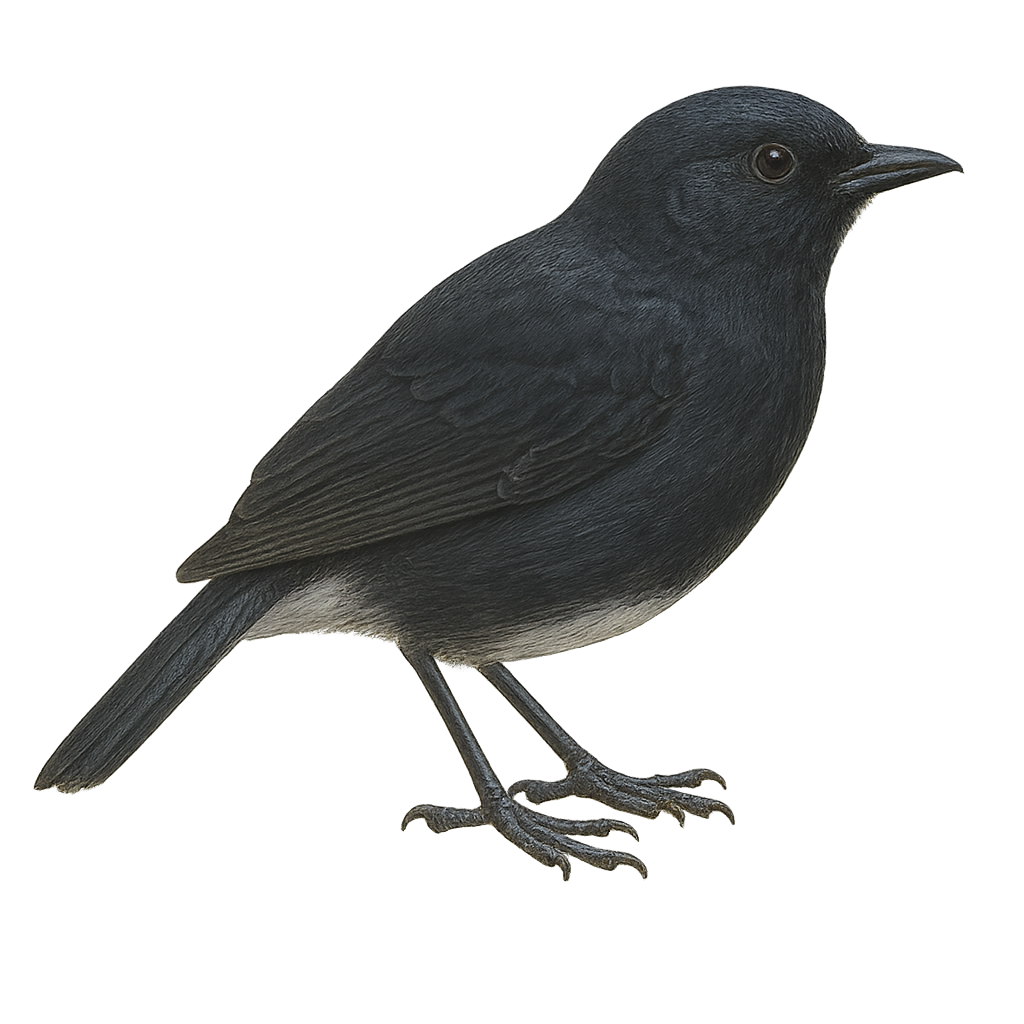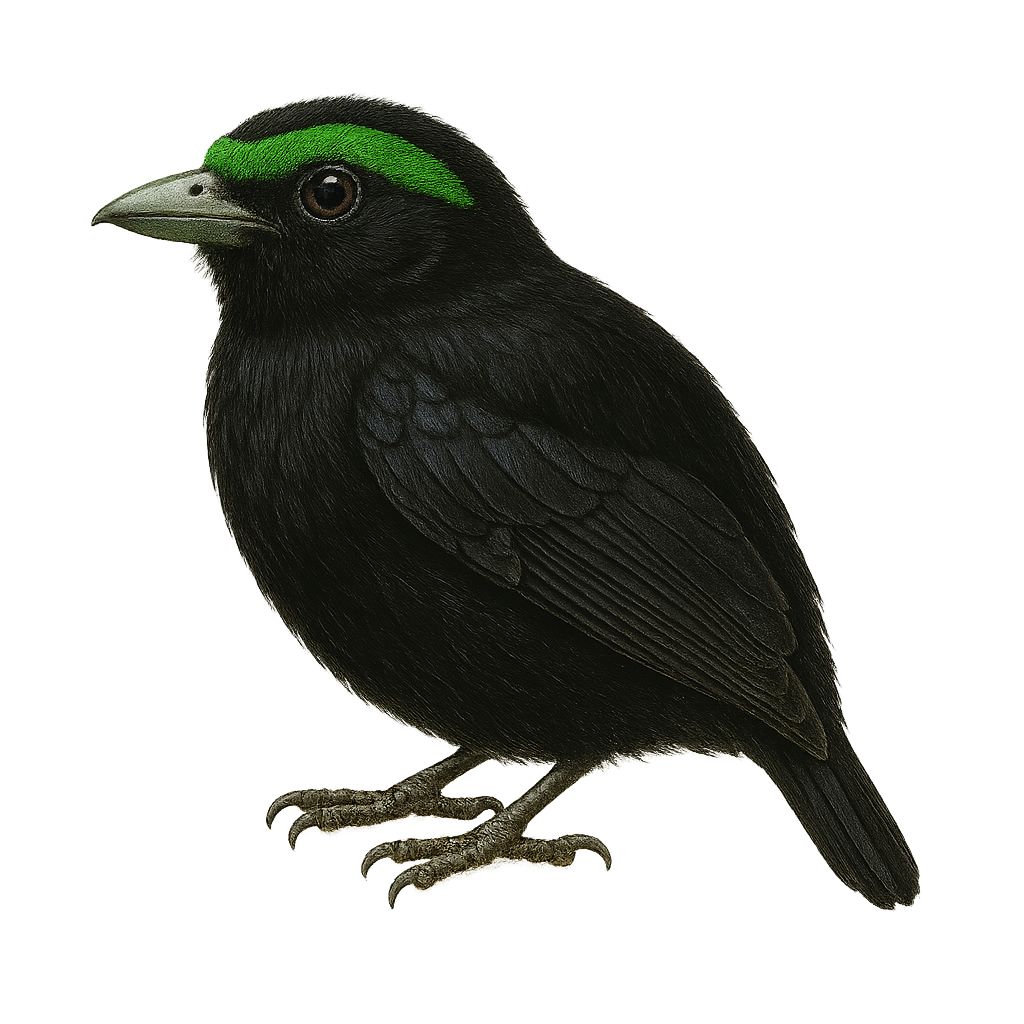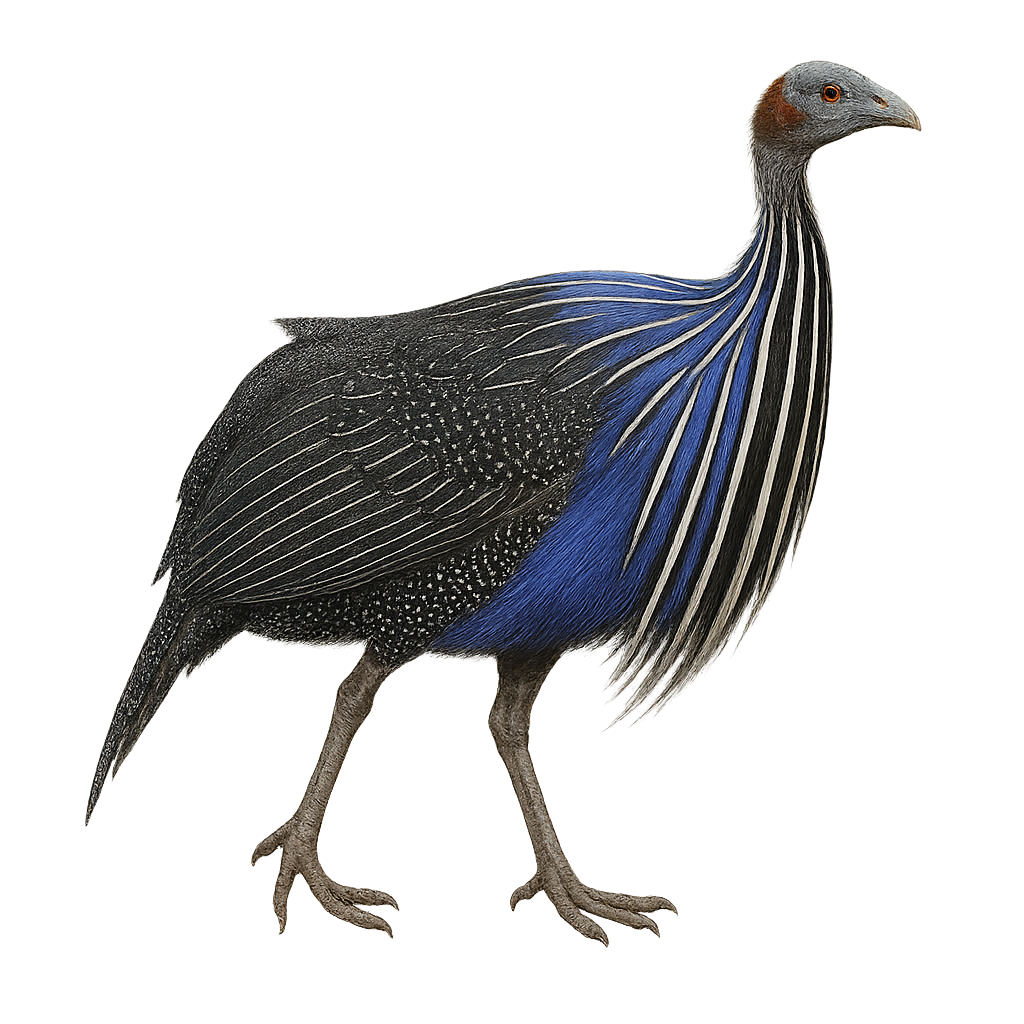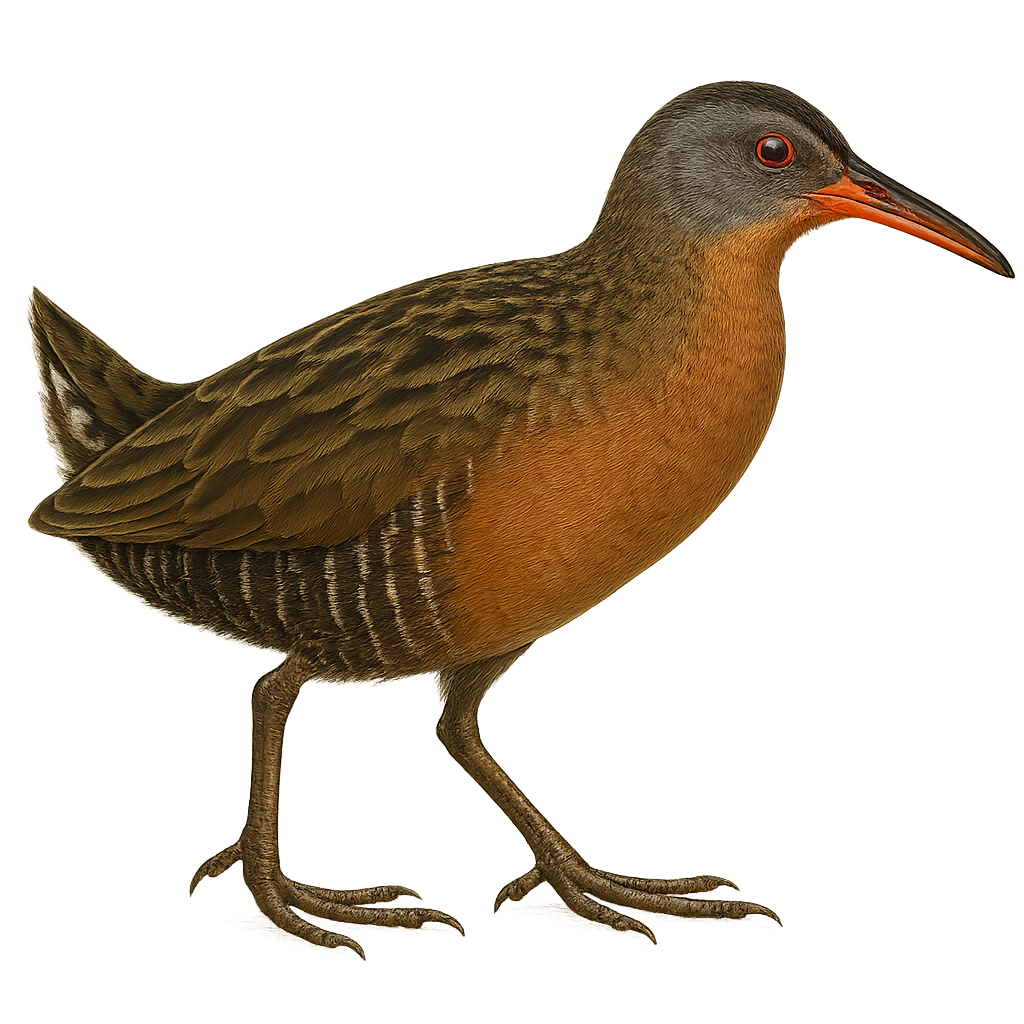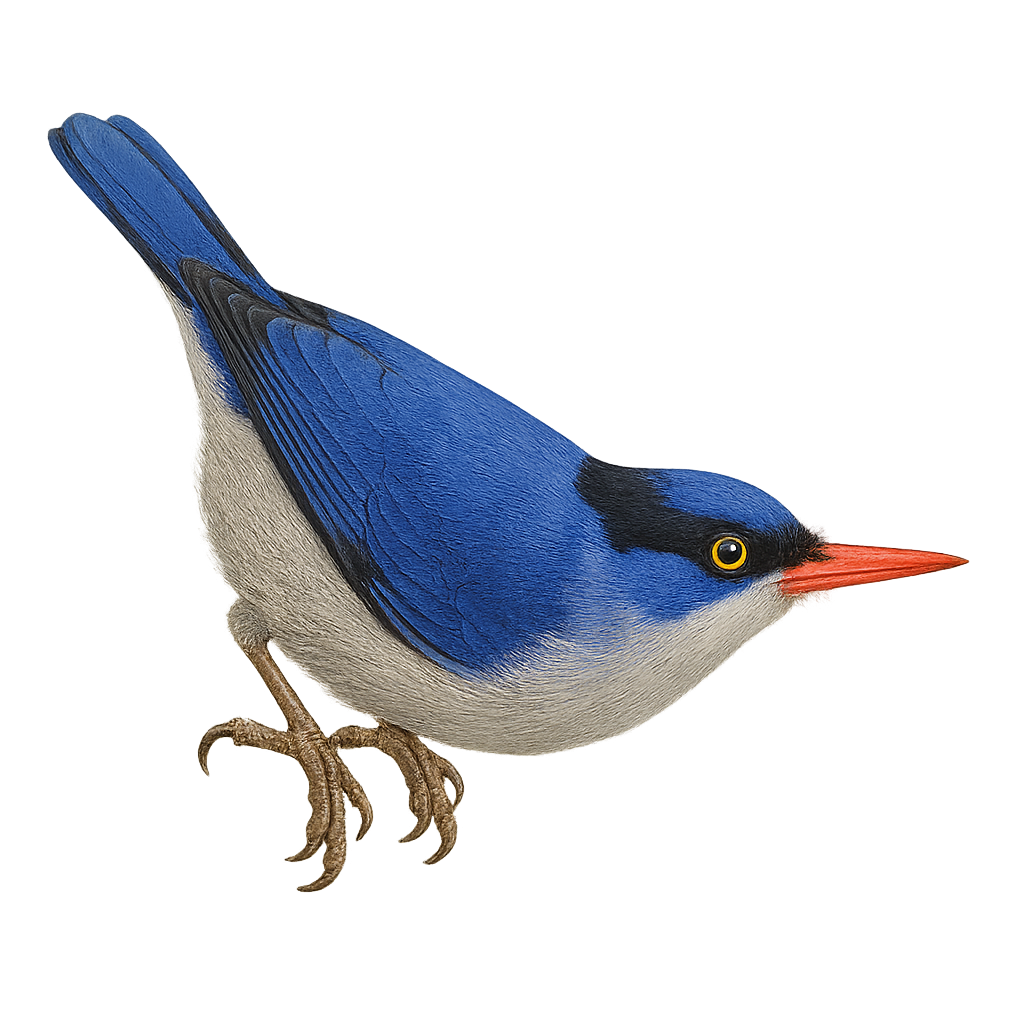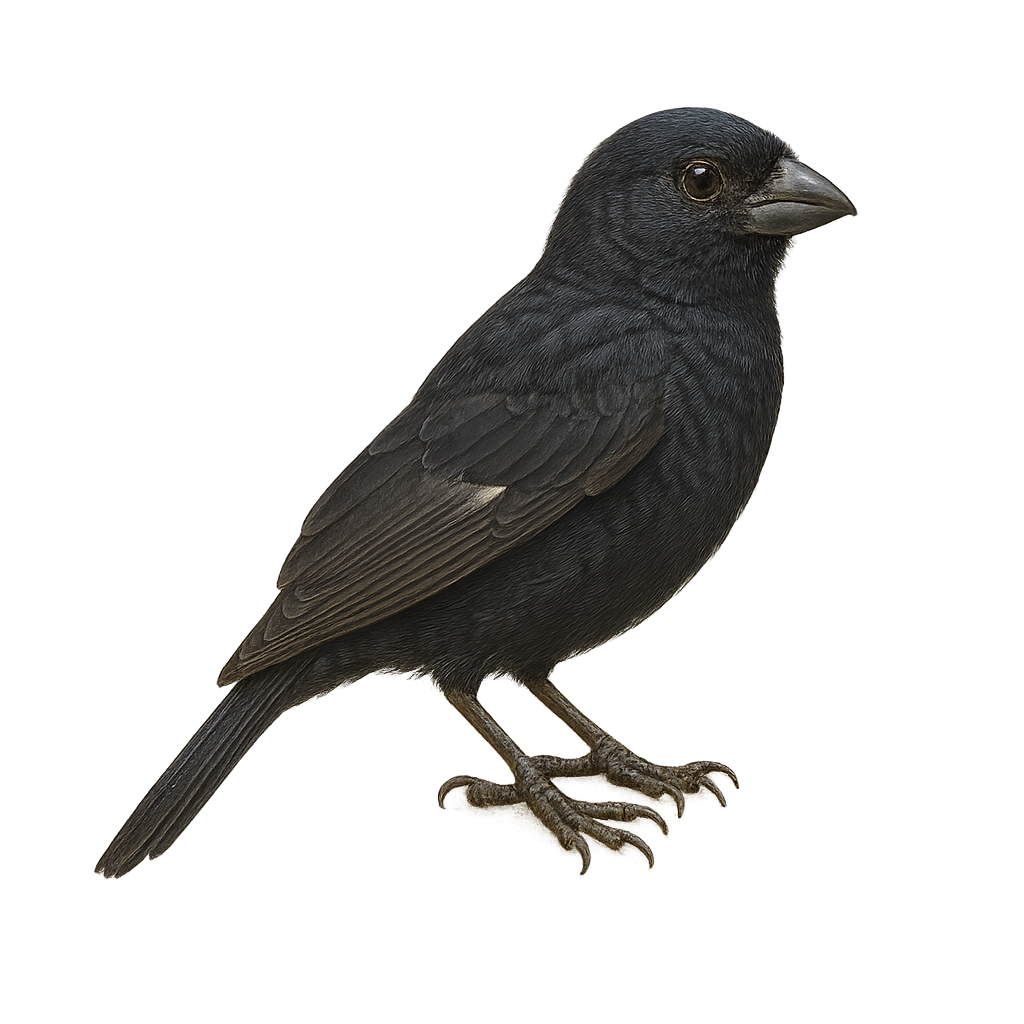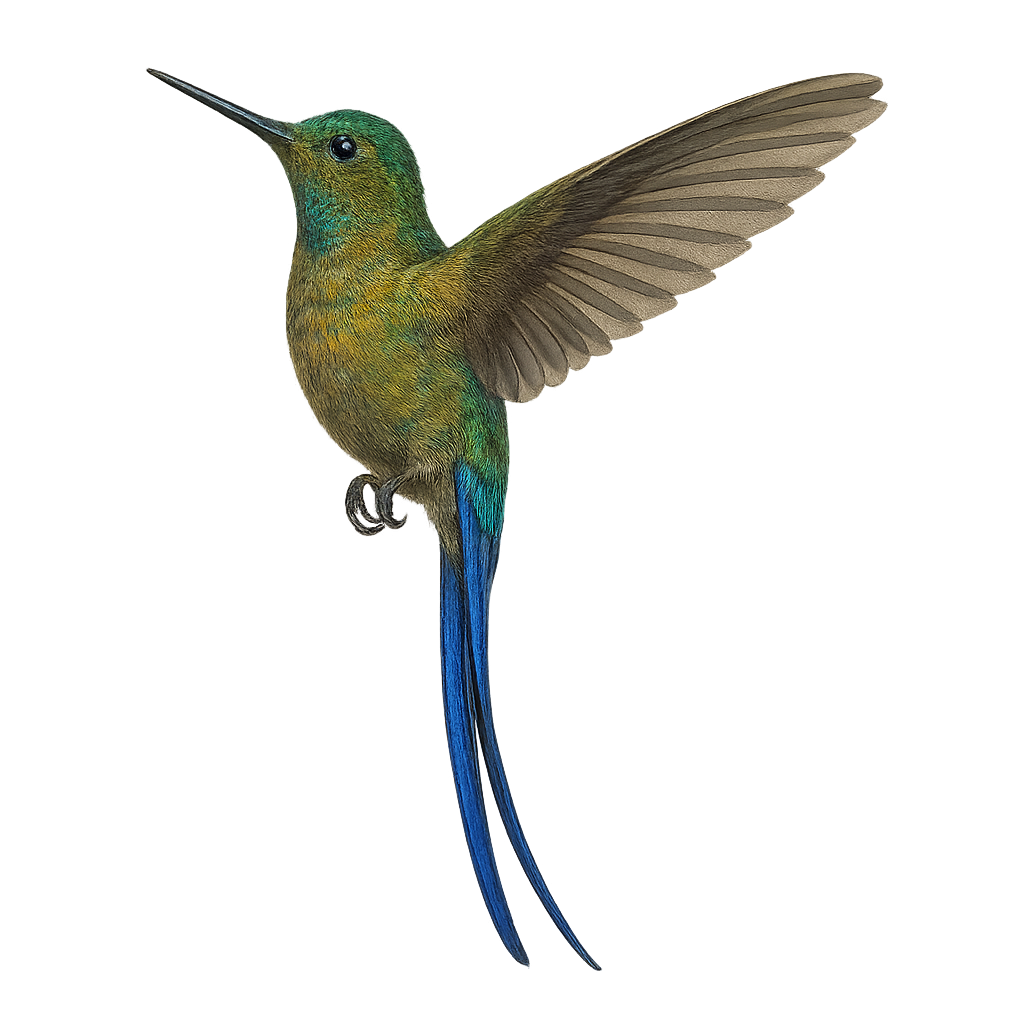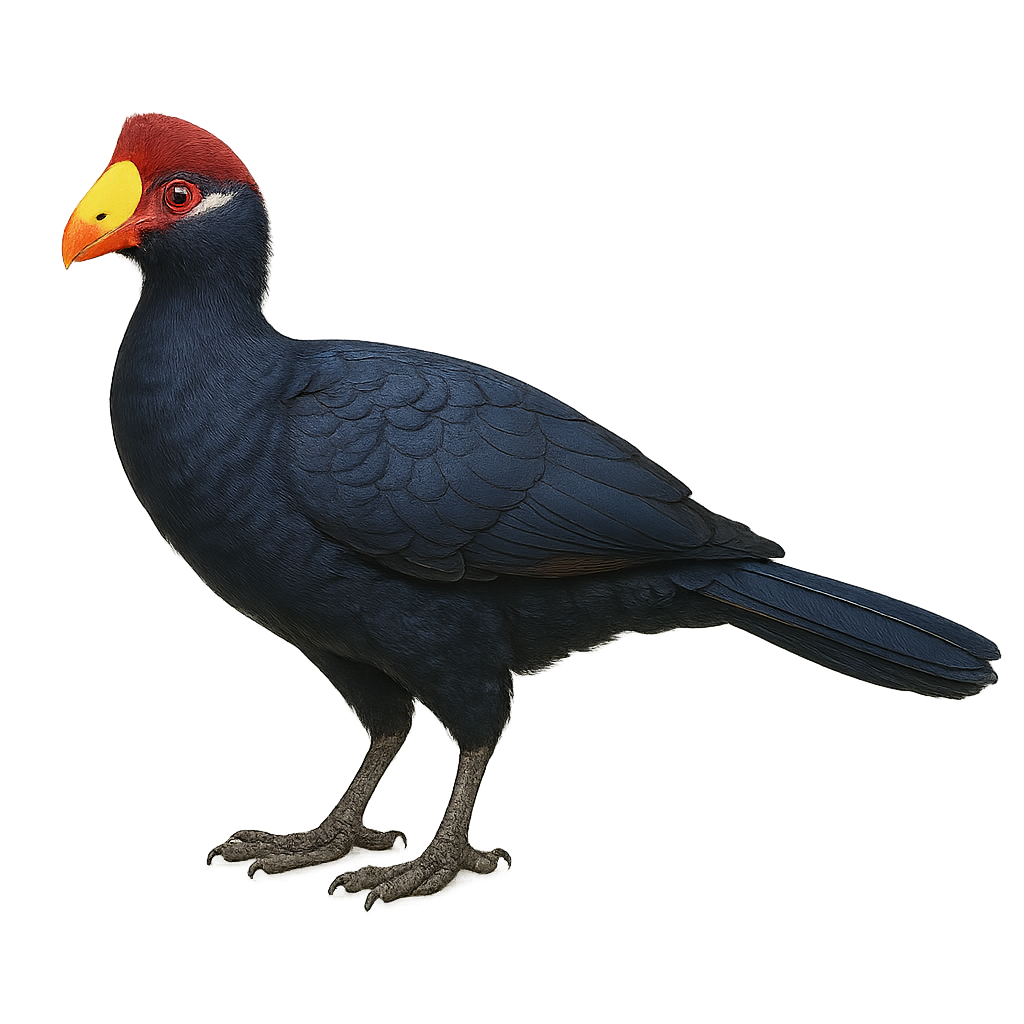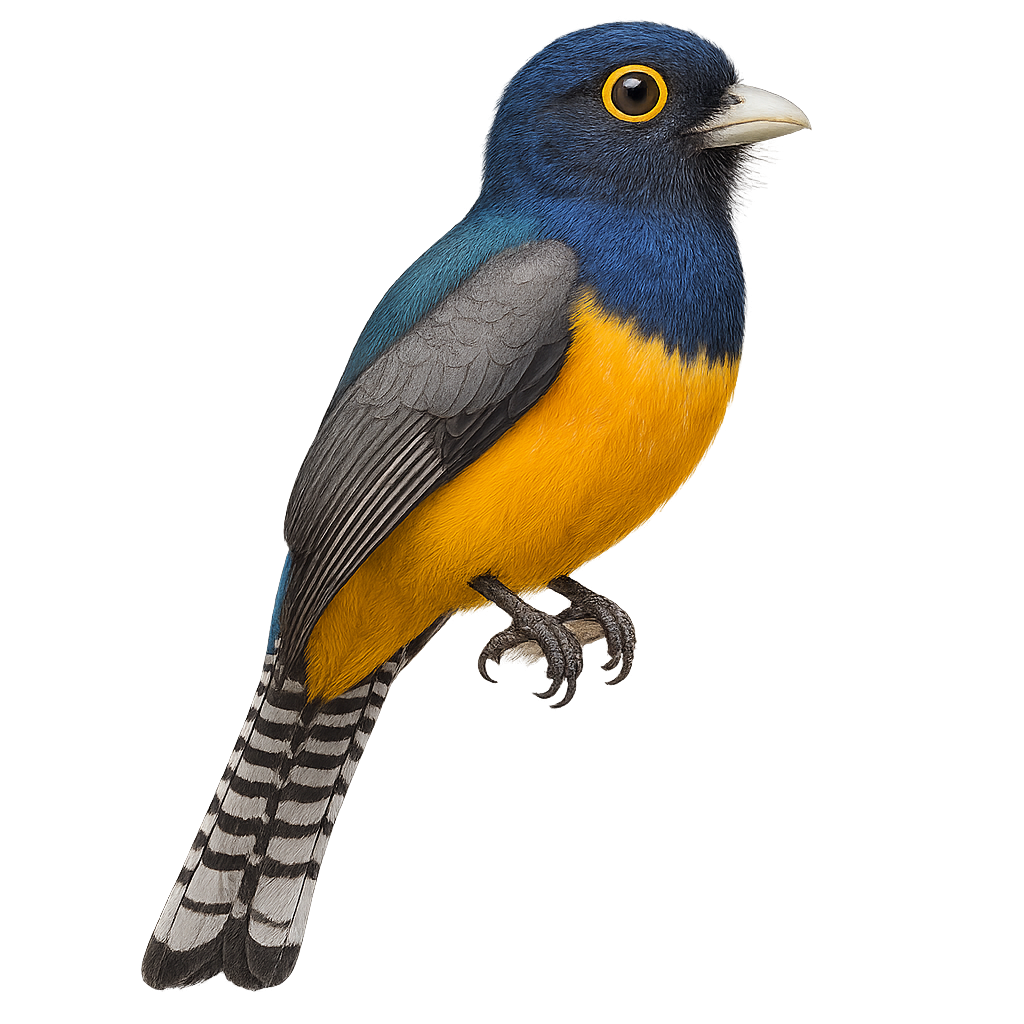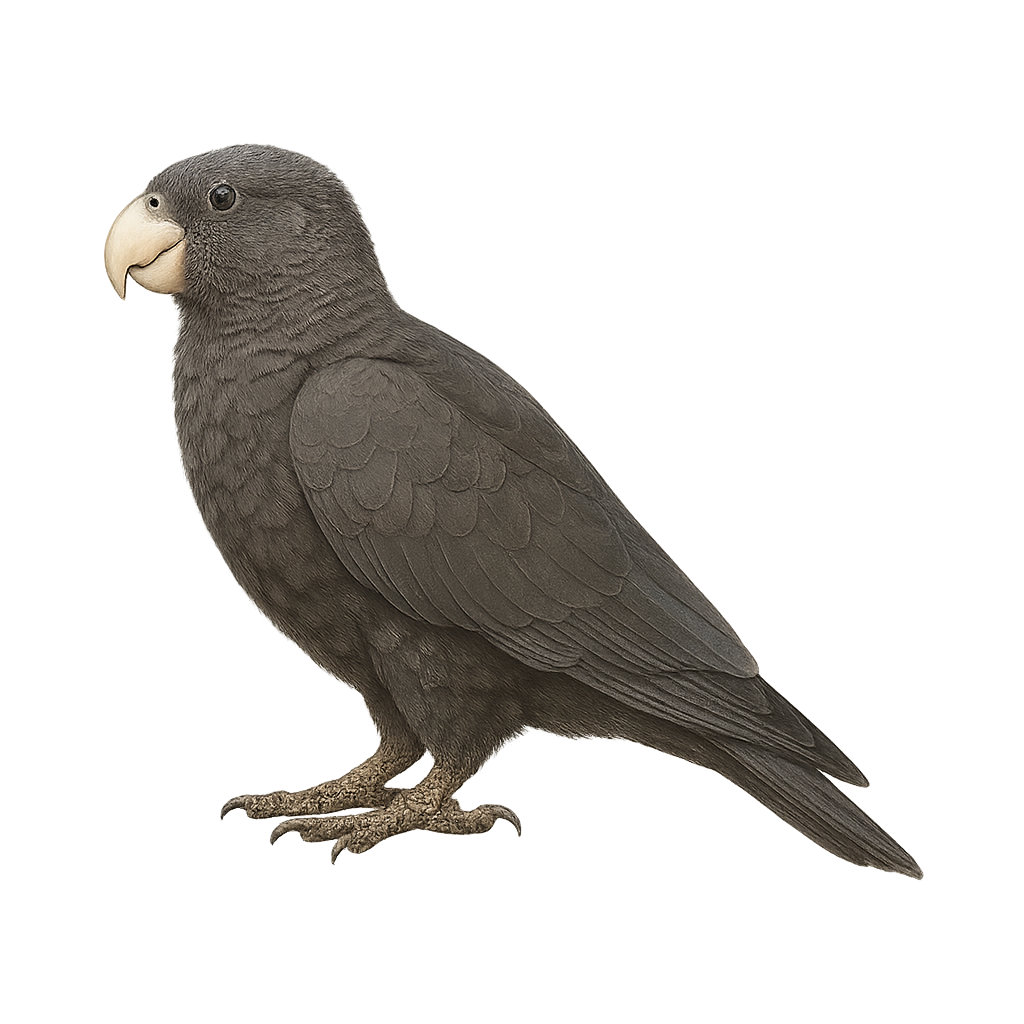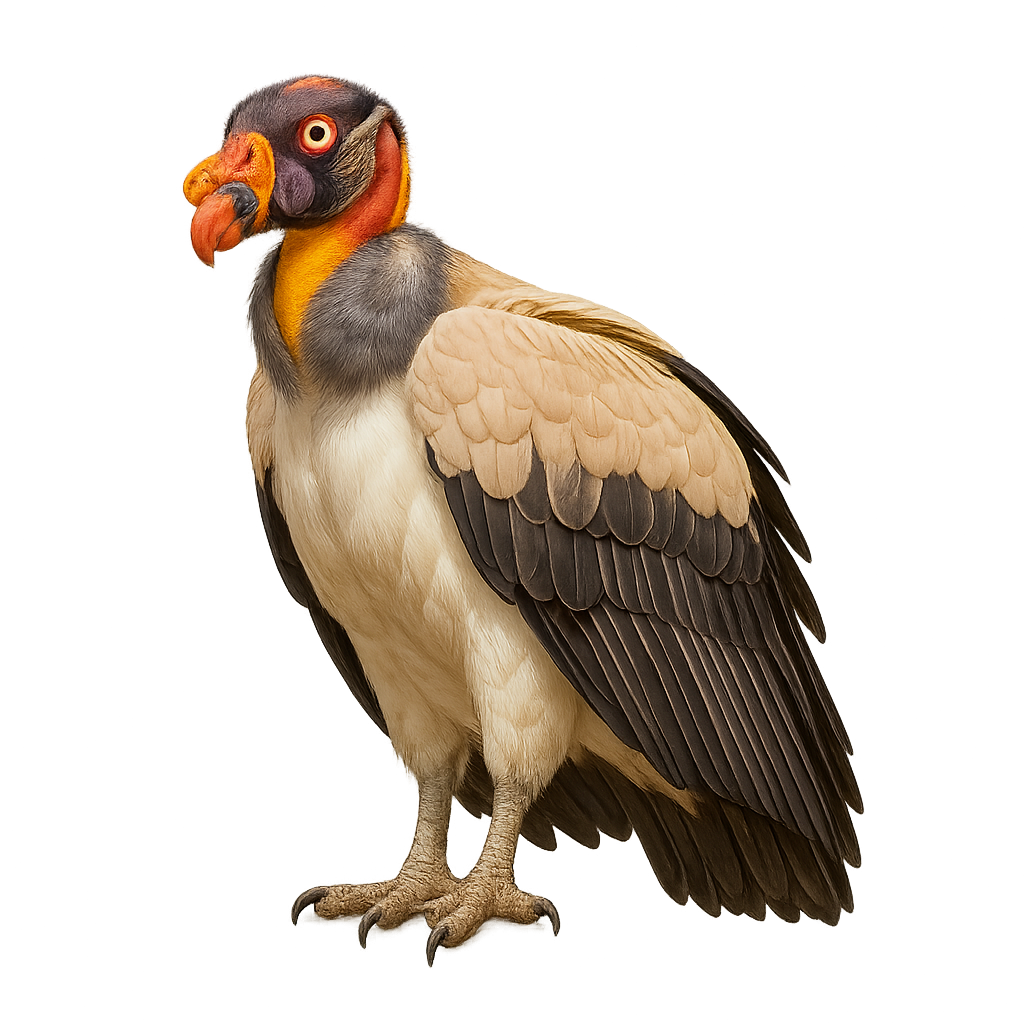The Von der Decken's Hornbill, scientifically known as Tockus deckeni, is a captivating bird native to East Africa, particularly Tanzania and Kenya. This hornbill is characterized by its striking black and white plumage and a large, often reddish bill in males. It primarily inhabits dry savannas, open woodlands, and bushy areas. These birds are known for their social behavior and tendency to live in small groups. They primarily feed on insects, fruits, and small reptiles. Their calls are often heard at dawn and dusk, marking their territory. The Von der Decken's Hornbill plays a crucial role in its ecosystem by aiding in seed dispersal.
The Visayan Hornbill, or Penelopides panini, is a bird species endemic to the Philippines, particularly the Visayan Islands. This medium-sized hornbill is notable for its black and white plumage with brownish cheeks. Males and females exhibit marked sexual dimorphism, with males having a larger bill and more vibrant coloration. These birds primarily inhabit tropical rainforests, feeding on fruits, insects, and small animals. Their social behavior is fascinating, as they often live in small family groups. Unfortunately, this species is threatened by deforestation and hunting, leading to a significant decline in its population.
The Velvet-purple Coronet, or Boissonneaua jardini, is a captivating hummingbird known for its striking plumage and agile movements. This hummingbird features a velvety purple plumage on its back and wings, contrasting with a metallic green belly. Males and females are similar, though females are slightly smaller. They inhabit the humid forests of the Andes, mainly in Colombia and Ecuador, where they feed on nectar and insects. Their rapid and precise flight allows them to navigate easily between flowers. The Velvet-purple Coronet plays a crucial role in pollinating local plants. Although generally solitary, these birds can be seen in groups around abundant food sources.
The Velvet-purple Coronet is a fascinating hummingbird, primarily found in the humid forests of the Andes. This small bird boasts a striking plumage with shades of purple and blue that captivate the eye. Known for its rapid flight and agile movements, it primarily feeds on nectar, which it extracts with precision using its long, slender beak. Males and females display similar colors, although males often have more vibrant hues. This hummingbird plays a crucial role in pollinating local plants, thus contributing to the biodiversity of its habitat. Despite its beauty, it can be challenging to observe due to its wary nature and dense habitat.
The Vernal Hanging Parrot, or Loriculus vernalis, is a small Asian parrot with vibrant green plumage and a distinctive blue head. This charming bird measures about 14 cm in length and is characterized by its short tail and rounded wings. It is primarily arboreal, inhabiting tropical rainforests, mangroves, and plantations. Its diet consists of fruits, flowers, and nectar. The Vernal Hanging Parrot is known for its ability to sleep upside down, hanging from a branch. Although relatively common within its range, it is often threatened by deforestation and capture for the pet trade.
The Verreaux's Coua is an endemic bird of Madagascar, belonging to the Cuculidae family. It is characterized by its predominantly blue-grey plumage with lighter shades on the belly. This medium-sized bird measures about 40 cm in length. It is often found in the dry forests and shrublands of southern Madagascar. The Verreaux's Coua is a terrestrial bird that prefers walking or running to flying. It primarily feeds on insects, small invertebrates, and occasionally fruits. Although its conservation status is concerning due to habitat loss, it remains relatively unknown to the general public.
The Trochalopteron variegatum, known as the variegated laughingthrush, is a richly colored bird primarily found in the mountainous forests of the Himalayas. Its plumage features a combination of gray, brown, and white, with distinctive patterns that make it easily recognizable. This bird is often seen in small groups, moving through the underbrush in search of food. It primarily feeds on insects, fruits, and seeds. Its song is melodious and varied, earning it the name "laughingthrush" in English. Although relatively common in its natural habitat, it remains discreet and can be difficult to spot due to its wary behavior.
The Pyrocephalus rubinus, or Vermilion Flycatcher, is a small bird with striking plumage, especially the male, which displays a bright red on its chest and head, contrasting with its dark brown back. This passerine is often seen perched on low branches, watching for insects to feed on. It is mainly found in South America, but can also be seen in parts of Central and North America. Its habitat ranges from open forests to semi-arid areas, including grasslands and riverbanks. The Vermilion Flycatcher is known for its spectacular courtship display, where the male performs acrobatic flights to woo the female.
The Victoria crowned pigeon is a majestic bird, recognizable by its large size and spectacular crest of white and blue feathers. Native to New Guinea, it primarily inhabits tropical rainforests. Its plumage is a striking blue, with purplish hues on the chest and distinctive white markings on the wings. This ground-dwelling bird feeds mainly on fruits, seeds, and insects. Although generally calm, it can emit low sounds to communicate with its peers. The Victoria crowned pigeon is a monogamous species, and pairs share the responsibilities of nesting and raising the young.
The Verreaux's Eagle-Owl, or Bubo lacteus, is an impressive nocturnal raptor, recognizable by its dark eyes and prominent ear tufts. It is the largest owl in Africa, measuring up to 66 cm in length with a wingspan reaching 1.5 meters. Its plumage is primarily gray with lighter shades on the belly. This skilled predator feeds mainly on small mammals, birds, and sometimes reptiles. It is often found in savannas, open forests, and wooded areas near watercourses. Although its conservation status is currently "Least Concern," habitat destruction could threaten its populations in the future.
The Violet-green Swallow, or Tachycineta thalassina, is a small migratory bird belonging to the Hirundinidae family. It is distinguished by its iridescent green and violet plumage on the back, contrasting with a white face and belly. It primarily inhabits wooded areas and open spaces near water, where it hunts flying insects. Its flight is agile and fast, allowing it to catch prey with precision. It often nests in natural cavities or artificial nest boxes. During the breeding season, it is very social and can form small colonies. Its presence indicates healthy aquatic ecosystems, as it relies on the availability of aquatic insects for food.
The Variable oystercatcher, or Haematopus unicolor, is a bird endemic to the Chatham Islands in New Zealand. It is characterized by its entirely black plumage, bright red long bill, and pink legs. This coastal bird is often seen on sandy beaches and rocky shores, where it primarily feeds on mollusks and crustaceans. Although its population is limited to a restricted region, it plays a crucial role in the local ecosystem by regulating prey populations. The Variable oystercatcher is monogamous and forms lasting pairs. Nesting occurs on the ground, often near the sea, where the eggs are well camouflaged among pebbles and seaweed.
The Velvety Manakin, or Lepidothrix velutina, is a small bird belonging to the Pipridae family. It is primarily found in the humid tropical forests of South America, particularly in Colombia and Venezuela. This bird is distinguished by its glossy black plumage in males, while females display more subdued olive-green tones. The Velvety Manakin is known for its spectacular courtship displays, where the male performs complex dances to attract the female. It primarily feeds on fruits and insects, playing a crucial role in seed dispersal. Despite its beauty, it remains relatively discreet and difficult to observe in its natural habitat.
The Varied Tit, Sittiparus varius, is a small, colorful bird native to East Asia, particularly Japan, Korea, and parts of China. It is distinguished by its vibrant plumage, which combines shades of black, white, rufous, and gray. This passerine measures about 12 to 14 cm in length and weighs between 16 and 18 grams. The Varied Tit is known for its sociability and curiosity, often seen in small groups in deciduous and mixed forests. It primarily feeds on insects, seeds, and fruits. Its melodious and varied song is a delight to birdwatchers. Although relatively common in its range, it is sensitive to environmental changes.
The Violaceous Euphonia, or Euphonia violacea, is a small, colorful bird from the Fringillidae family, predominantly found in South America. It is characterized by its vibrant plumage, with a blue-violet back and bright yellow belly. Males display more vivid colors than females, who are generally duller. This bird is often seen in tropical rainforests, forest edges, and wooded areas. It primarily feeds on fruits but can also consume insects and seeds. The Violaceous Euphonia is known for its melodious song, often heard at dawn and dusk.
The Venezuelan Flowerpiercer is a bird from the Thraupidae family, endemic to the humid montane forests of Venezuela. It is recognizable by its dark plumage, often blue-black, and its thin, hooked beak, adapted for piercing flowers to feed on nectar. This bird is about 12 cm long and weighs between 10 and 15 grams. It is often seen in small groups or pairs, actively moving through the canopy in search of food. Although its habitat is limited, it is not currently considered threatened, but deforestation could pose a long-term risk.
The Velvet Asity, or Philepitta castanea, is a bird endemic to Madagascar, belonging to the Eurylaimidae family. It is recognizable by its velvety black plumage in males, with a bright yellow rump, while females have more subdued tones. This bird primarily inhabits the island's humid tropical forests, where it feeds on fruits and insects. During the breeding season, the male performs spectacular courtship displays to attract the female. The species is currently classified as "Near Threatened" by the IUCN due to deforestation and habitat loss.
The Vulturine Guineafowl, Acryllium vulturinum, is a striking bird known for its vibrant plumage and graceful appearance. Native to the arid regions of East Africa, this bird is distinguished by its bare blue head, surrounded by a collar of black and white feathers. Its body is covered with bright blue feathers speckled with white spots, creating a striking contrast. It lives in social groups, often seen moving together in search of food. Although it prefers walking, it can fly short distances when threatened. Its distinctive call echoes through the savannas and dry forests it inhabits.
The Virginia Rail is a medium-sized waterbird, measuring about 20 to 27 cm in length. It is recognizable by its reddish-brown plumage on the back and wings, and its gray belly. Its long, slightly curved bill is perfect for probing mud in search of food. This bird prefers marshes and wetlands where it can hide among the reeds. It is often heard rather than seen due to its secretive behavior and dense habitat. The Virginia Rail primarily feeds on insects, small crustaceans, and seeds. It is known for its distinctive calls, often described as repeated "kik-kik-kik" sounds.
The Velvet-fronted Nuthatch is a small, colorful bird, primarily blue with a distinctive yellow cap. It is often seen in the dense tropical forests of Southeast Asia, where it moves nimbly along trunks and branches in search of insects and seeds. Its social behavior is notable, as it often travels in small groups, emitting high-pitched calls to communicate. Although primarily arboreal, it occasionally descends to the ground to forage. Its ability to climb headfirst down trees is characteristic of nuthatches. The Velvet-fronted Nuthatch is a resilient bird, capable of adapting to various forest habitats, but remains vulnerable to deforestation.
The Variable Sunbird, or Cinnyris venustus, is a small, colorful bird belonging to the Nectariniidae family. It is primarily found in sub-Saharan Africa, where it inhabits various environments such as savannas, open forests, and gardens. This sunbird is recognizable by its vibrant plumage, with metallic green hues on its back and yellow shades on its belly. Males often display brighter colors than females. They primarily feed on nectar but also consume insects to supplement their diet. These birds are known for their fast and agile flight, allowing them to move easily between flowers.
The Variable Seedeater, or Sporophila corvina, is a small passerine bird belonging to the Thraupidae family. This charming bird is primarily found in Central America, from southern Mexico to western Panama. It is easily recognizable by its distinctive black and white plumage, with a black belly in males, while females display more brownish hues. This passerine frequents various habitats, from tropical forests to open agricultural areas. It is often seen feeding on seeds and insects, making it an important player in seed dispersal. Although generally tolerant of human presence, it can be suspicious in disturbed environments.
The Violet-tailed Sylph, Aglaiocercus coelestis, is a captivating hummingbird found in the humid forests of western Ecuador and Colombia. This small bird boasts a dazzling plumage with shades of emerald green and metallic blue, and a long, elegant tail that gives it a graceful appearance. Males are distinguished by their longer tails and more vibrant colors compared to females. They primarily feed on nectar but also consume small insects to supplement their diet. Their rapid and agile flight allows them to move easily between flowers, playing a crucial role in pollination.
The Violet Turaco, or Tauraco violaceus, is a fascinating bird known for its striking plumage and captivating social behaviors. Native to the dense forests of West Africa, this bird features predominantly violet plumage with shades of green and red on its wings, making it easily recognizable. It measures about 45 cm in length and has a distinctive crest. The Violet Turaco is an arboreal bird, moving nimbly through the canopy in search of fruits, its primary food source. It is also known for its distinctive vocalizations, often described as raucous calls. Although generally tolerant of human presence, it prefers habitats where vegetation is dense, providing protection from predators.
The Violaceous Trogon is a medium-sized bird, measuring about 23 to 25 cm in length. It is distinguished by its striking plumage, with a metallic green back and bright yellow belly. Its head is adorned with a violet hue, giving it its name. This bird primarily inhabits the humid tropical forests of Central and South America, where it feeds on fruits and insects. It is often observed perched silently in the canopy, moving agilely between branches. The Violaceous Trogon is a discreet bird, but its melodious and repetitive song often betrays its presence. Although it is relatively tolerant of human presence, it prefers dense wooded areas where it can easily hide.
The Coracopsis vasa, commonly known as the Vasa Parrot, is a parrot endemic to Madagascar. It is notable for its blackish plumage, which turns brownish during the breeding season. This medium-sized parrot, measuring about 50 cm, has a strong beak and a relatively long tail. Its call is harsh and distinctive, often heard in the dry and humid forests of the island. The Vasa is a social bird, frequently observed in noisy groups. It primarily feeds on seeds, fruits, and flowers. Its ability to adapt to various habitats, from forests to savannas, makes it a resilient species. However, deforestation and capture for the pet trade threaten its population.
The King vulture is a large raptor from the Cathartidae family, recognizable by its bare red head and dark plumage. This vulture, which inhabits mainly the forests and savannas of Central and South America, primarily feeds on carrion, which it finds thanks to its excellent sense of sight and smell. It plays an essential ecological role in cleaning ecosystems. Despite its imposing size, it is often seen flying alone or in small groups. While protected, it is threatened by habitat loss and poisons used in certain hunting practices.


